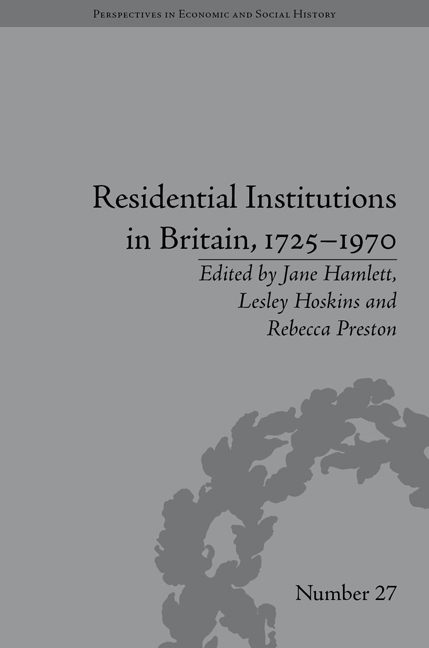Book contents
- Frontmatter
- Contents
- Acknowledgements
- List of Contributors
- List of Figures
- Introduction
- 1 Viewing the Early Twentieth-Century Institutional Interior through the Pages of Living London
- 2 ‘French Beef was Better than Hampstead Beef’: Taste, Treatment and Pauperism in a London Smallpox Hospital, 1871
- 3 From Asylum to Mental Hospital: Gender, Space and the Patient Experience in London County Council Asylums, 1890–1910
- 4 Refuge or Prison? Girls' Experiences of a Home for the ‘Mentally Defective’ in Scotland, 1906–1948
- 5 Paupers and their Experience of a London Workhouse: St Martin-in-the-Fields, 1725–1824
- 6 ‘A Veritable Palace for the Hard-Working Labourer?’ Space, Material Culture and Inmate Experience in London's Rowton Houses, 1892–1918
- 7 ‘The Place was a Home from Home’: Identity and Belonging in the English Cottage Home for Convalescing Psychiatric Patients, 1910–1939
- 8 ‘The Father and Mother of the Place’: Inhabiting London's Public Libraries, 1885–1940
- 9 ‘Discipline with Home-Like Conditions’: The Living Quarters and Daily Life of the Women's Army Auxiliary Corps in First-World-War Britain and France
- 10 Halls of Residence at Britain's Civic Universities, 1870–1970
- Notes
- Index
1 - Viewing the Early Twentieth-Century Institutional Interior through the Pages of Living London
- Frontmatter
- Contents
- Acknowledgements
- List of Contributors
- List of Figures
- Introduction
- 1 Viewing the Early Twentieth-Century Institutional Interior through the Pages of Living London
- 2 ‘French Beef was Better than Hampstead Beef’: Taste, Treatment and Pauperism in a London Smallpox Hospital, 1871
- 3 From Asylum to Mental Hospital: Gender, Space and the Patient Experience in London County Council Asylums, 1890–1910
- 4 Refuge or Prison? Girls' Experiences of a Home for the ‘Mentally Defective’ in Scotland, 1906–1948
- 5 Paupers and their Experience of a London Workhouse: St Martin-in-the-Fields, 1725–1824
- 6 ‘A Veritable Palace for the Hard-Working Labourer?’ Space, Material Culture and Inmate Experience in London's Rowton Houses, 1892–1918
- 7 ‘The Place was a Home from Home’: Identity and Belonging in the English Cottage Home for Convalescing Psychiatric Patients, 1910–1939
- 8 ‘The Father and Mother of the Place’: Inhabiting London's Public Libraries, 1885–1940
- 9 ‘Discipline with Home-Like Conditions’: The Living Quarters and Daily Life of the Women's Army Auxiliary Corps in First-World-War Britain and France
- 10 Halls of Residence at Britain's Civic Universities, 1870–1970
- Notes
- Index
Summary
Living London: A Window on the Institutional Interior
This chapter examines the photographic representation of a range of residential institutions within a collection of early twentieth-century writings, Living London: Its Work and its Play, its Humour and its Pathos, its Sights and its Scenes, edited by George R. Sims and published by Cassell & Company between 1902 and 1903. The collection made a variety of urban environments visible to a contemporary readership for the first time and offers an opportunity to look across institutional sites and typologies to explore common aspects of their spatial, material and aesthetic organization, their status as dwelling places, and their relationship with an idealized domesticity, rooted in an understanding of the home as a moral centre for family life and a foundation of social stability. Drawing on a selection of images, it considers the visual evidence that Living London's photographs offer for a relationship between the design of institutional interiors and those of private homes of the period, as well as the ways in which domestic ideals informed the representational choices of the collection's photographers and editor.
Living London, an ambitious attempt to record the panoply of metropolitan social experience at the start of the twentieth century, incorporated 175 articles and somewhere in the region of 1,500 photographs and other illustrations. The series was published fortnightly at a cost of 7 pence and in three bound volumes that sold for 12 shillings each, making it affordable to a middle-class audience and almost certainly available to a wider working-class readership.
- Type
- Chapter
- Information
- Residential Institutions in Britain, 1725–1970Inmates and Environments, pp. 17 - 34Publisher: Pickering & ChattoFirst published in: 2014



